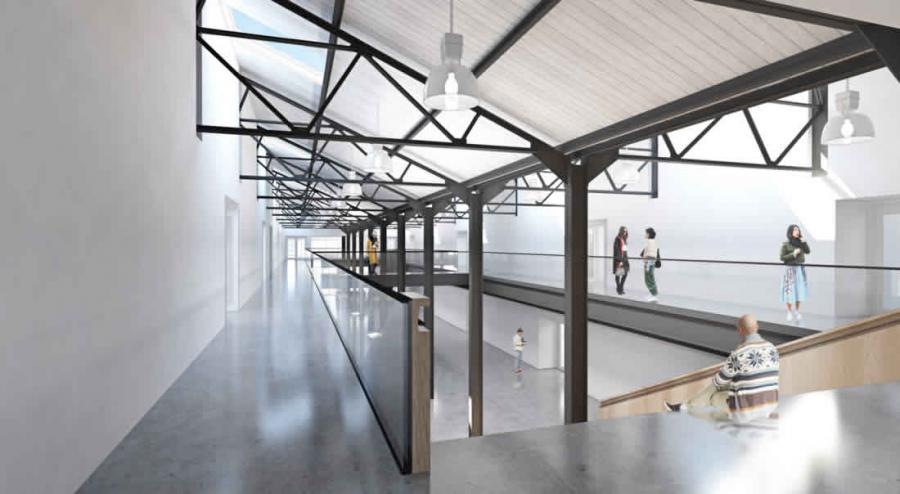Minnesota Street Project: San Francisco’s Newest Arts Nexus
by Sura Wood
Philanthropists/arts enthusiasts Deborah and Andy Rappaport are the driving forces behind Minnesota Street Project, a lifeline for local gallery owners and artists in a rapidly changing cityscape.
For decades, the area surrounding San Francisco’s Union Square has been the heart of the city’s commercial gallery district. Due to skyrocketing rents, fueled by the influx of tech companies and rising real estate values, that is changing. Some galleries have relocated, while others have reestablished their business online or simply shuttered their doors. A number of gallery owners—Catherine Clark, Todd Hosfelt, Brian Gross, George Lawson and Jack Fischer—have migrated to Potrero Flats, southwest of San Francisco’s Design District. The nearby Dogpatch neighborhood, where the much-anticipated Minnesota Street Project (MSP) opens later this month, seems poised to become the latest arts hot spot.
“I left downtown because of the…untenable rent increase,” recalls Fischer, who three years ago departed from 49 Geary, which was, until fairly recently, the locus of prestigious galleries. Fischer set up shop on Potrero Avenue, a space he’ll keep in addition to launching a new gallery at MSP.
“In a way, MSP duplicates what 49 Geary once was,” he says. “The synergy a hub [can] generate [ultimately benefits] all the galleries.”
MSP comprises three main buildings on Minnesota Street that offer affordable, below-market rates to Bay Area artists and dealers: 1150, a storage and handling facility for collectors and galleries, provides over 100,000 square feet of space, a portion of it climate controlled; 1240, a former T-shirt printing factory, is a cavernous barn with aluminum siding and soaring ceilings that houses studios for 27 long-term tenants (who have the option to stay indefinitely), selected from almost 300 applicants, as well as additional short-term rotating spaces that will accommodate around two dozen artists a year; and 1275, an unassuming two-story warehouse structure once occupied by a furniture maker, now renovated and redesigned by Jensen Architects (the firm that recently completed work on the David Ireland house at 500 Capp St.) and encompassing 11 contemporary art galleries, the nonprofit San Francisco Arts Education Project, a pair of rotating exhibition spaces, a media room, showers, a kitchen and bike storage for staff plus a café and restaurant. Its updated interior has industrial finishes, exposed high ceilings, concrete floors, wooden stairways, white walled galleries of varying sizes and a glass breezeway connecting the second floor venues. Between the galleries lining either side on the ground floor is an atrium area that can be used for special events.
San Francisco collectors and arts patrons Deborah and Andy Rappaport—a retired venture capitalist—are the Minnesota Street Project’s founders. Concerned about the future of art in San Francisco, they sought a sustainable model for the city’s arts community. They began searching for alternative, affordable spaces two years ago. “We had to do this quickly because we were performing a triage operation here,” explains Deborah Rappaport. “If we didn’t get spaces open as fast as we possibly could…galleries would have gone dark…and artists wouldn’t have been able to hang on if they didn’t know there was a possibility of something like this coming along.” She says they considered sites in the Mission District, SOMA and Bayview before finally settling on Minnesota Street. “When I first walked in the building, if I believed in angels, I would’ve heard them singing. It was the perfect space and that was before the renovations.”
Among the advantages of the neighborhood are plentiful parking and its accessibility to South Bay art enthusiasts and collectors. Yet moving to a venue less centrally located had its risks. That did not deter Rena Bransten, who was the first to sign on. Bransten had a gallery at 77 Geary for 27 years before moving to a succession of other spaces, most recently a temporary project venue on Market Street leased prior to committing to MSP.
“The Union Square ground-floor environment had gravitated away from local businesses toward luxury chain stores…and the congestion around downtown traffic and construction was intense,” says gallery co-director Trish Bransten. “Evenwith the knowledge that SFMOMA would be three blocks away, the lure of other areas of the city, and the excitement created by the growth, changing demographics and expansion in other parts of the Bay Area was compelling. Ours is a story of displacement and gravitation toward a center where we could be near other galleries—to compete, share ideas and have access to artists and the vision of our colleagues. Deborah and Andy Rappaport were a gravitational pull for us as well.”
Nancy Toomey of Nancy Toomey Fine Art, who closed her gallery at 49 Geary in March 2015 after 17 years, was another early convert. “I was seeking a sense of community and common purpose, more fun [and] a belief that art can actually change lives and enhance our humanity,” she says. “The Rappaports… just want it to be possible for artists to have affordable studios and for galleries to be able to show cutting-edge or difficult subject matter ….”
“This is the way we could make the most difference to the arts community writ large,” says Deborah Rappaport, who envisions the Minnesota Street Project evolving into an inviting, diverse community that, over time, will spawn development of similar spaces in the area. “We’re set up for longevity,” she says. “I’m good with forever."
